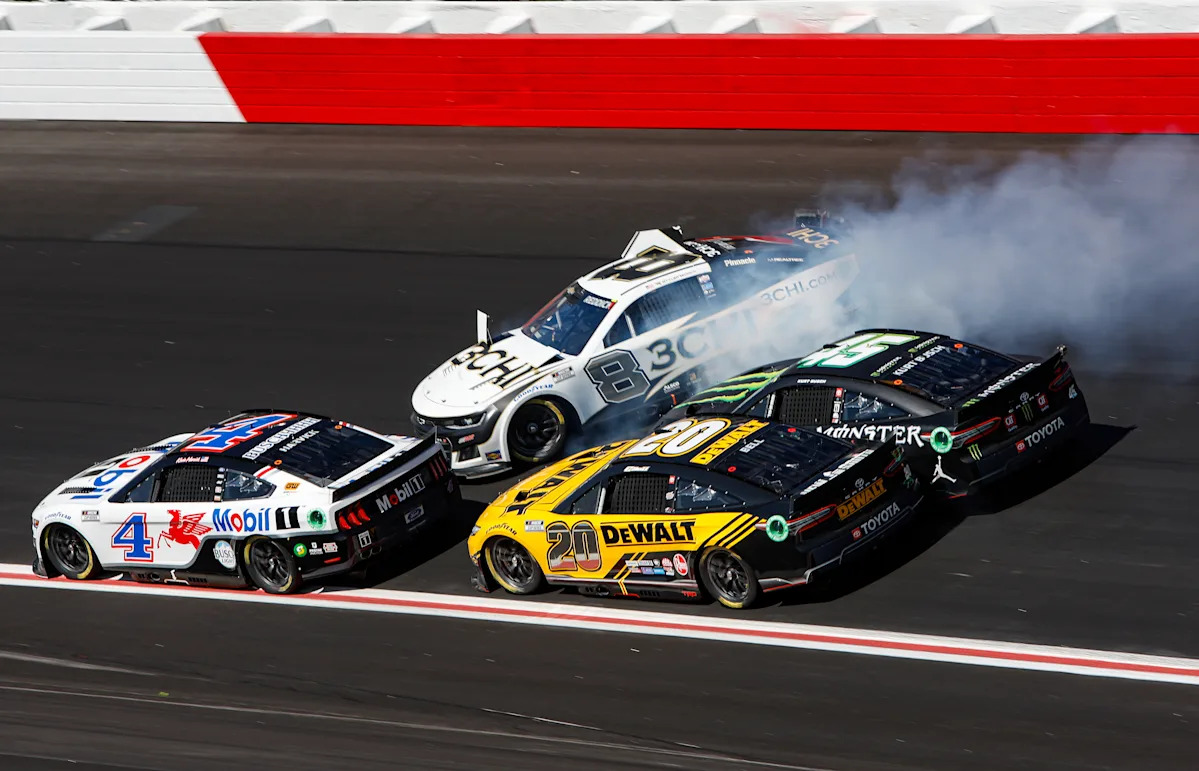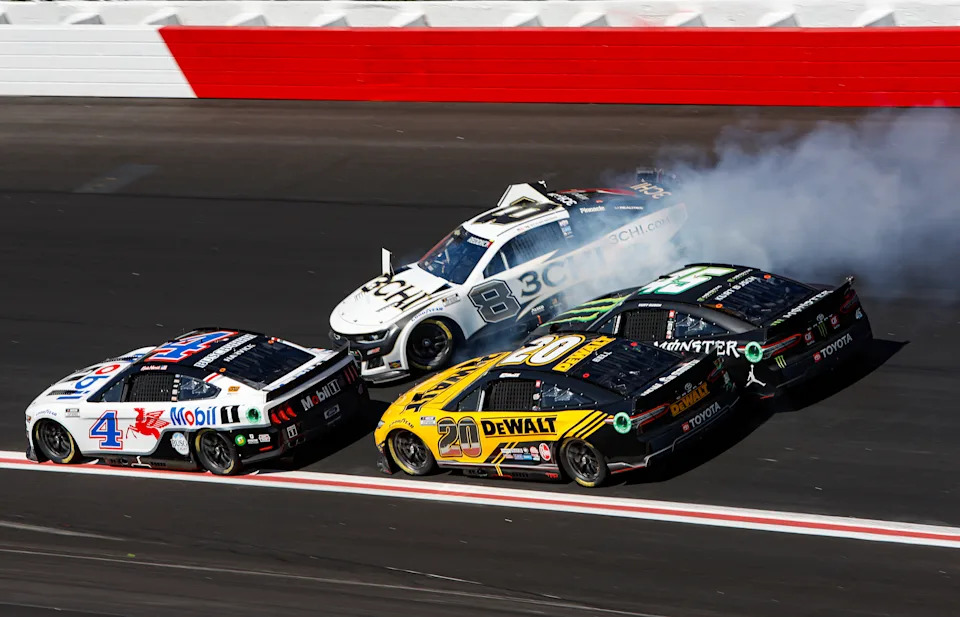## Fueling the Debate: Is NASCAR a Sport or a Spectacle?
The roar of engines, the smell of burnt rubber, the thrill of a last-lap pass. NASCAR races are a sensory overload, leaving fans on the edge of their seats. But as Yahoo Sports recently pondered, is NASCAR a sport, or is it just high-octane entertainment?

The Chase: Engineered Excitement

NASCAR’s foray into manufactured drama reached its zenith with the introduction of “The Chase.” Debuting in 2004, this playoff-style format aimed to inject heightened tension into the final ten races of the season. The concept was simple: The top twelve drivers in the standings at the time of the Chase’s commencement would be reset to zero points, and their subsequent performance in the ten-race playoff would determine the champion. While the Chase undeniably delivered moments of nail-biting suspense, as evidenced by Tony Stewart’s one-point triumph over Carl Edwards in 2011, it also sparked debate about its impact on the integrity of the season-long competition.
Critics argue that The Chase, by artificially concentrating the narrative into a truncated period, diminishes the significance of consistent performance throughout the entire season. A driver who dominated the first 26 races could still be eliminated in the Chase’s early stages, effectively rendering their earlier dominance inconsequential. This raised questions about whether NASCAR was prioritizing manufactured drama over rewarding sustained excellence.

Successes and Limitations
Despite these criticisms, The Chase undoubtedly achieved its primary objective: generating excitement and heightened fan engagement. The condensed playoff format created a sense of urgency and heightened expectation, drawing viewers in with the promise of high-stakes racing. However, the Chase’s limitations became increasingly apparent as time went on. The reset system, while intended to create parity, often favored drivers who had a strong final ten-race run, regardless of their overall performance throughout the season. This led to situations where drivers who had struggled earlier in the year could suddenly become championship contenders, which some viewed as undermining the narrative of consistent excellence.
Moreover, the Chase format became increasingly predictable, with the same handful of drivers consistently making it to the final round. This repetition, coupled with the inherent randomness of racing, led to a sense of deja vu among some fans, who craved a more unpredictable and dynamic championship battle.
Manufactured Moments
Beyond the Chase, NASCAR has been accused of manipulating events to create compelling storylines. From phantom debris cautions to strategically timed crashes, the perception persists that NASCAR subtly influences the race outcome to deliver an entertaining spectacle. While NASCAR vehemently denies any intentional manipulation, instances like the infamous 2007 Nextel Cup Series finale at Miami-Homestead Speedway fueled these suspicions. That race saw a controversial caution flag waved with just a handful of laps remaining, ultimately setting up a photo finish between Jimmie Johnson and Jeff Gordon. The situation sparked accusations of NASCAR playing favorites and manipulating events to ensure Johnson’s championship victory.
The ethical implications of such manufactured moments are complex. On the one hand, a well-timed caution flag or a carefully orchestrated crash can heighten tension and keep viewers on the edge of their seats. On the other hand, it raises questions about the authenticity of the competition and the integrity of the sport. If NASCAR is manipulating events to create drama, are the race results truly earned? Or are they simply the product of a carefully orchestrated script?
The Line Between Entertainment and Authenticity
Finding the right balance between delivering captivating narratives and preserving the integrity of competitive racing is a constant challenge for NASCAR. While the sport undeniably benefits from the occasional manufactured moment, too much interference can erode fan trust and undermine the essence of genuine competition. Ultimately, the success of NASCAR hinges on its ability to strike a delicate balance between captivating entertainment and authentic sporting competition.
Fan Engagement vs. Authentic Competition
NASCAR’s constant pursuit of “entertainment” has led to a fundamental tension: the desire to captivate audiences with thrilling storylines versus the need to maintain the integrity of authentic competition. This tension is particularly evident in the sport’s embrace of pack racing, a style of racing that prioritizes close proximity and high-speed maneuvering, often resulting in chaotic and unpredictable outcomes. While pack racing can undoubtedly deliver thrilling spectacles, it also raises concerns about driver safety and the overall quality of racing. Critics argue that pack racing emphasizes luck and circumstance over skill and strategy, often leading to multiple cars becoming involved in accidents, diminishing the impact of individual driver performance.
NASCAR’s response to this criticism has been to implement rule changes aimed at promoting more strategic racing within pack conditions. These rules often seek to mitigate the risk of collisions by reducing the number of cars able to run closely together or by incentivizing drivers to race more cautiously. However, the delicate balance between fostering exciting racing and ensuring driver safety remains an ongoing challenge for NASCAR.
The Dilemma of Manufactured Drama
Ultimately, the question of whether NASCAR prioritizes entertainment over authenticity is a matter of perspective. Some argue that the sport’s manufactured moments are simply a necessary evil in an era of dwindling viewership and a need for heightened competition. Others, however, believe that NASCAR should focus on celebrating the inherent drama of racing, rather than trying to artificially inject it into the sport. The tension between these two viewpoints is likely to continue as NASCAR navigates the ever-evolving landscape of sports entertainment.
The Atlanta Experiment: A Pack Racing Reality Check
The Speedway Motorsports’ reconfiguration of Atlanta Motor Speedway in 2022, aimed at producing more pack racing akin to Daytona and Talladega, provided a real-world laboratory for testing the limits of this style of racing. The track’s redesign, featuring narrower corners and steeper banking, was designed to encourage drafting and close-quarters racing, creating a high-speed spectacle that NASCAR hoped would draw in fans.
Speedway Motorsports’ Transformation
The results of the Atlanta experiment were both fascinating and unsettling. While the new track delivered on its promise of exciting racing, it also highlighted the inherent dangers and limitations of pack racing. The high speeds and close proximity of the cars resulted in a record number of caution flags and crashes, leading some to question the long-term viability of this style of racing.
The Price of Pack Racing
The Atlanta race was a microcosm of the challenges facing NASCAR as it tries to balance the pursuit of exciting racing with driver safety and the integrity of competition. While the spectacle of pack racing can be undeniably thrilling, the high number of crashes and the increased risk of serious injury raise valid concerns. Furthermore, critics argue that pack racing often reduces the importance of driver skill and strategy, turning races into a lottery of luck and circumstance.
Lessons Learned and Future Directions
The Atlanta experiment, while undoubtedly entertaining, served as a cautionary tale for NASCAR. It demonstrated the potential pitfalls of overemphasizing pack racing and highlighted the need to strike a delicate balance between excitement and safety. The future of NASCAR will likely involve a continued exploration of different racing styles and a refined approach to rule-making, all aimed at delivering a compelling and entertaining spectacle while ensuring the safety of drivers and the integrity of competition.
Conclusion
So, is NASCAR a sport or entertainment? As Yahoo Sports so eloquently laid out, the line blurs, and the answer likely lies somewhere in the grey. We’ve explored the undeniable athleticism required of drivers, the meticulous engineering and strategy involved, and the genuine risk they face. We’ve also delved into the staged aspects, the spectacle, and the marketing machine that surrounds the sport. Ultimately, the beauty of this debate lies in its subjectivity.
What constitutes a “sport” is a complex question with no definitive answer. Perhaps the significance isn’t in definitively labeling NASCAR, but in recognizing its unique blend of elements. It demands physical and mental prowess, strategic brilliance, and a willingness to push boundaries. It also thrives on the drama, the pageantry, and the emotional connection it fosters with its fans. As technology advances and racing continues to evolve, this question will undoubtedly persist and spark further debate. Will NASCAR become even more performance-driven, or will it lean further into the realm of entertainment? Only time will tell, but one thing remains certain: NASCAR’s ability to captivate and ignite passion in millions around the world is undeniable.
It’s a sport that transcends the checkered flag, leaving us to ponder: what truly defines a champion, and what role does entertainment play in our pursuit of athletic excellence?